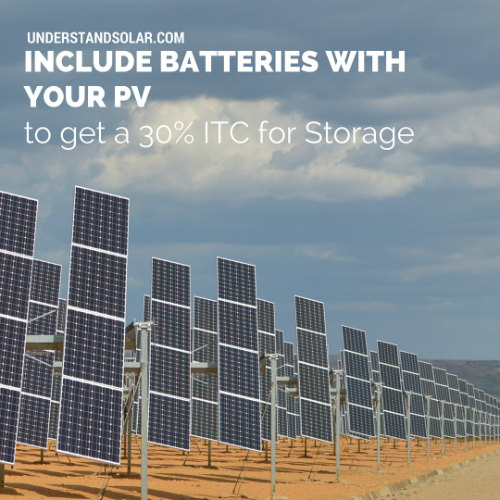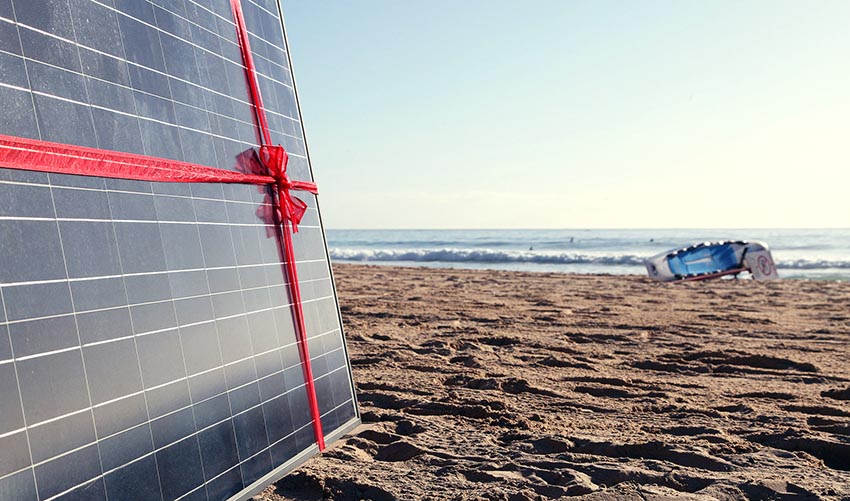Claiming The Solar ITC: IRS Form 5695 Instructions

While advancements in efficiency and the natural cost decline as the technology has been refined are partly to thank for solar’s astounding growth, one major factor in this feat is the ITC (Solar Investment Tax Credit).
Here we’ll take a look at what the investment tax credit is and how you can use it to your advantage, as well as how to use IRS Form 5695, the document required to claim the credit.
What is the ITC?
The Investment Tax Credit is a government incentive designed to support the installation of renewable energy via solar panels. The concept behind the move was to give renewable energy sources such as wind and solar a chance to become accessible enough to compete with traditional energy sources. The credit applies to both homes and businesses, providing a dollar for dollar return on a portion of the installation and equipment costs.
The solar ITC allows tax filers to receive a tax reduction equal to 30% of the cost of solar installations on eligible property (either residential or commercial). The Energy Policy Act of 2005 originally authorized the ITC to apply from the beginning of 2006 through the end of 2007; however, the credit was extended for another year via the Tax Relief and Health Care Act of 2006. In 2008, the Emergency Economic Stabilization Act implemented an eight-year extension on the incentive and made utility companies and other businesses which pay the AMT (alternative minimum tax) eligible as well.

The ITC was set to expire at the end of 2016; however, in December 2015, Congress passed another extension which allows for the credit to be phased out gradually between 2016 and 2023. The claimable amount will remain at 30% for all systems on which construction is begun before the end of 2019, is reduced to 26% in 2020, and 22% in 2021. After the year 2023, the residential credit will be eliminated and the commercial and utility credits lowered to 10%.
While the solar ITC is a dollar for dollar credit, rather than a deduction, it is not refundable – meaning that if you don’t owe the IRS as much money as your credit is worth, they will not issue a refund for the difference. On the other hand, the credit is not considered income so you will not have to claim it as such on your following year’s taxes.
How much can you save with the ITC?
With the implementation of the incentive’s extension, the situation for residential solar customers improved drastically as far as the amount they are able to save on their tax bill. The original credit included a clause capping the amount of the tax reduction at $2000. The extension removed this cap, making way for homeowners to save a hefty chunk of change on their installations.
The average cost of a solar installation in the United States, including equipment, is typically between $15,000 and $30,000, depending upon the size of the system (residential systems usually range between 3kW and 8kW). The ITC is calculated based upon the price you pay after any rebates or discounts.
So if, for example, your system costs $20,000, and the solar installation company is offering a promotion for a $3000 rebate, your total out-of-pocket cost will be $17,000. In this case your renewable energy tax credit savings would be $5100. If you paid the full price for your system, you’re looking at $6000 in savings on your tax liability.
It’s important to note that if you have two homes which you use as residences, you must pro-rate your claim for the amount of time you spend in the home which has solar. For instance, if you spend half the year in one home and half in the other, you can only claim half of the credit amount for the home that has the installation. In other words, on a $20,000 system, you’d claim $10,000, for a tax savings of $3,000.
The Federal Solar Tax Credit in 2017
Sometimes things aren’t better for those who wait, and the Federal Solar Tax Credit is one of them. The longer you wait, the less money you will get back on your solar installation. If you want to get back 30% of the money you put into your solar installation come tax time, it’s time to get your act in gear and start calling installers for quotes! The credit starts to decrease in just two years, so as long as you have proof that you started constructing a solar array before the end of 2019, you’ll be eligible for the full credit amount!
Form 5695
You can claim the Investment Tax Credit by filing IRS Form 5695 along with your tax return. You’ll want to keep the instructions close at hand while filling the form out, as you will need to follow specific steps in calculating amounts from your 1040 in order to fill the form out properly.
Begin by filling in your Form 1040 up to line 53. At this point you will move on to start on Form 5695. The first thing you will need to calculate for the form is the total of costs for your installation. These may include preparation, assembly, labor, equipment, and any other associated costs such as labor and equipment required to tie the system into the utility grid. You can obtain certification from your solar installer verifying the eligible costs associated with your system. You keep this certification for your own records – the IRS does not require you to submit it with your tax return.
Many people have raised questions regarding whether or not the cost of a new roof would be eligible as one of these costs of installation, if the roof must be replaced in order to install the solar panels. The IRS makes clear that a standard roof, even if needed in order to install the system, may not be included in these costs.
The exception is if the roof itself has specific properties designed to increase energy efficiency, such as a coated metal or asphalt roof. In this case, the difference between the cost of this specialized roof and a normal roof may qualify for a Form 5695 energy credit. Be sure to consult your tax professional to find out exactly how to include this cost in your claim.

Once you’ve determined the total cost of all associated elements of the installation, you will be prompted to calculate 30% of these costs and add that number to any energy credit you may be eligible to carry forward from the previous tax year. There are also lines which allow you to enter information about any other energy improvements you’ve made, such as solar water heating or fuel cell property.
In order to complete the next portion of the form, you must use information from Form 1040 about your total tax liability in order to figure out how much of the energy credit you’re actually eligible for. There is a worksheet included in the Form 5695 instructions, which allows you to calculate other tax credits you’re taking, in order to figure out how much of the ITC you can actually take.
What can you use IRS Form 5695 for?
Form 5695 is a multi-purpose form which allows you to calculate and claim a variety of residential energy credits.
There are two categories of energy credits covered by this form – the residential energy-efficient property credit, and the nonbusiness energy property credit.
The form is also used to carry forward any leftover energy credits you may have from the year before. Following is a breakdown of the types of costs which would be entered on Form 5695:
#1 Residential Energy Efficient Property Credit (Part I of the form)
• Qualified solar electric property costs (these are the aforementioned equipment and installation costs associated with installing your solar panel system).
• Qualified solar water heating property costs (in order to qualify, at least half of the energy produced by the solar water heating system must come from the sun).
• Qualified small wind energy property costs – this installation must utilize a wind turbine to produce power for your home.
• Qualified geothermal heat pump property costs – this is a system which uses the ground, or groundwater, in order to provide heating or cooling to your home.
• Qualified fuel cell property costs – in order to qualify, the fuel cell system must have a minimum half-kilowatt capacity with a greater than 30% electricity-only generation efficiency.
It’s important to note that there is a $500 limit per half-kilowatt of capacity on the fuel cell property tax credit.
#2 Residential Energy Property Credit (Part II)
This part of the energy credit is limited to 10% of the costs associated with qualified energy efficiency improvements, with a combined cap of $500, $200 for windows, $50 for an advanced main air circulating fan, $150 for gas, propane, or oil furnaces, and $300 for energy-efficient property. In addition, energy efficient components must be expected to be used for at least five years in order to qualify.
Qualified energy efficiency improvements include:
• Insulation materials or system designed to decrease heat gain or loss
• Exterior doors, windows, and skylights
• Roofs that are designed to increase energy efficiency, such as asphalt, or metal with pigmented coatings
Qualified energy property includes:
• Specific heat pump water heaters, air conditioners, gas, propane, or oil water heaters, or stoves which use biomass fuel
• Advanced main air circulating fans that are used with gas, propane, or oil furnaces
• Qualifying natural gas, propane, or oil furnaces or hot water boilers
It’s a good idea to check with your tax professional and/or your energy-efficient equipment installer to ensure that the system you’re purchasing will meet IRS qualifications for these credits.
Form 5695 Filing Tips and Other Considerations
As with most tax laws, the details of qualifying and filing for energy efficiency credits are complex and specific. There are several things to keep in mind not only as you file your tax return, but ideally long before that, as you go through the decision-making process in purchasing and installing energy-efficient improvements.
• If you lease your solar panel system, or enter into a PPA (power purchase agreement), you will not be eligible to claim the ITC. In a solar lease or PPA, the developer or installer owns the system, and therefore owns the rights to any associated tax credits.
• While you may claim the ITC on property which is not your main residence, you may not claim this incentive on rental property that you own. The home must serve as your residence for at least part of the year.
• You must claim your ITC in the tax year following the installation, and the system must be paid for (whether in cash or via financing). You may not claim the credit for a system which already exists on a home you’ve purchased, or for one that has been purchased prior to the current tax year.
• You may roll over any unclaimed credit to the following tax year. For example, if you purchase your system in 2016, and you owe $2000 in taxes but your ITC amount is $4000, you may use that remaining $2000 against your 2017 tax liability. Even if you have no tax liability in the year of installation, you still need to file Form 5695 in order to qualify for the rollover.
• If you decide at some point in the future to install additional panels onto your system, those panels and any accompanying materials and labor are eligible for the Investment Tax Credit in the year in which they were installed, even if your main system was installed years prior.
• While the ITC is applicable to homes other than your main residence, fuel cell property as well as energy efficiency improvements (windows, doors, etc.) and energy property (water heaters, furnaces, etc.) must be installed in your main home in order to qualify for a credit.
The ITC has brought renewable energy into reach for hundreds of thousands of households, helping to expedite the process of allowing this technology to compete with conventional energy sources. If you decide to take advantage of this incentive, be sure to keep up to date with the current version of IRS Form 5965 so you can reap the benefits of all possible tax credits for which you qualify.
